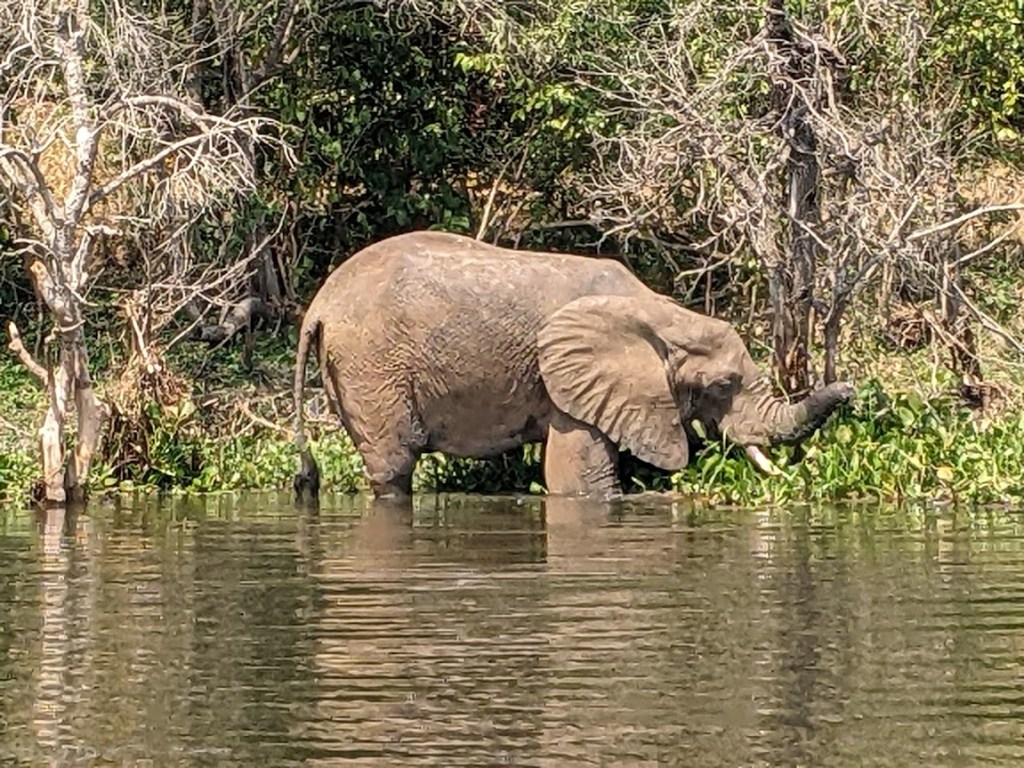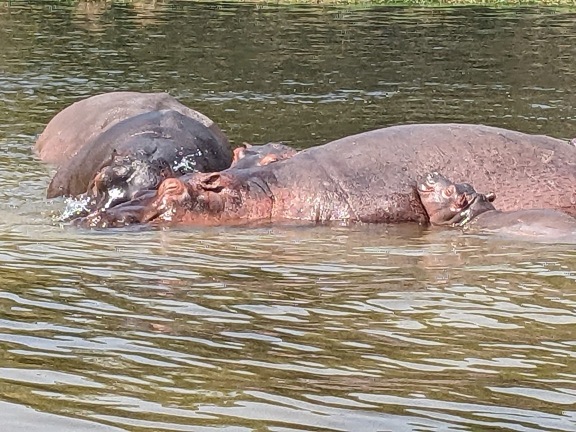We hit the road at six thirty on our first full day at Murchison Falls.
From the beginning of this trip, I’ve accepted that getting up early is the price of being there when the wildlife comes out and does spectacular things. Innocent pointed out on our way back to the Lodge in the late morning — when very little game was visible at the time — that most animals don’t like the midday heat any more than we do. They hide under a bush or in a burrow, and we stop seeing anything very interesting. So that’s when we go rest from the midday heat ourselves. The critters have the right idea.

This was a national park, so we couldn’t go off the roads. But there was plenty of wildlife that strayed comfortably close to the roads. Innocent helped me identify the new species of antelopes, with which I had great fun. The Ugandan Kob is their version here of the impala, in that they are absolutely everyplace, and all the predators happily eat them for breakfast, lunch and dinner.
There was also the Jackson’s Hartbeest, which has a looong head and looong horns, so its face looks like it’s been stretched in a fun-house mirror when you see it head-on. I don’t know much about its actual personality, but it looked as if the word ‘dour’ had been invented for it personally. And there were waterbucks, a different type from in the south; and baby Kobs as cute as every other baby antelope I’ve ever seen. One of them, I caught in the middle of nursing.

I also, finally, saw buffalo on a game drive!! I’d seen one buffalo from the air when I took that helicopter ride over Victoria Falls, and I’d seen several at the side of the highway when I was trying to get someplace. (In one case, they were all on the highway, preventing us from getting anywhere at all, but fortunately not for too long.) But until today, I had never seen buffalo on a regular game drive. They were as inexplicably absent as the elephants were.

I did see elephants today, incidentally. In reasonably normal quantities. Ugandan elephants do not appear to play tricks on me in the same way that southern elephants do.
The restaurant at Murchison River Lodge kindly packed us a breakfast to take with us, and we also had the pineapples that Innocent insisted on buying me yesterday. So we stopped beside the Nile to eat. There were at least five other cars there, including another Speke car, but it didn’t bother me the way it had bothered me in Zimbabwe when we pulled up at a beautiful spot for sundowners and found several other cars that wanted to stop there too. Some of the reason for this is because the other cars today were there first, so I never felt that I had a right to the space we had found. But also, everyone made this communal meal into a party. Since pineapple goes bad within a day anyhow, whatever of the first pineapple I couldn’t eat, we gave out to the people from other cars. There was a lot of visiting from car to car, and a lot of laughter, and it all felt much less as if I were being crowded, and more like we were all having a breakfast party. It was actually a lot of fun.
Innocent doesn’t carry a radio for contact with other drivers — it’s just not the way they do it in Uganda. Instead, they call each other’s cell phones. And pretty much as soon as we pulled out from our breakfast spot, Innocent’s phone began ringing frantically. It seemed like every driver who was in the park with us wanted to deliver the same urgent message: Lions!!!
The lions were all the way on the other side of the park. We hurried, but we were ironically slowed down by the endless pressure of continuous phone calls, wanting to know if we were really coming, and urging us to hurry because the lions were starting to stand up and move.
We did hurry, but paused briefly for one extraordinary sight on the road: a small clan of hyenas (yes, that’s what you call a group of hyenas) who were crossing the road in broad daylight! This was a rare find. Normally, hyenas are nocturnal and go back to their dens by daybreak; this clan must have been out just a little later than usual, and we caught them on their way home. At any rate, I was thrilled. I’ve never understood why most people seem to dislike hyenas. I think they’re graceful, soft-eyed, and beautiful.

We finally joined the crowd around the lions, just in time to watch an adult male and female cross the road and disappear into the tall grass. I was disappointed to see them go… but I wasn’t the only one disappointed. Their young cub somehow got left behind on the other side of the road. There were now several cars between him and his parents, and that appeared to be too much for this cub to handle. After two or three abortive attempts to run the gauntlet of so many cars, he sat down in the grass and cried for his mama.
I never knew before that baby lions meow. It’s possible the cutest thing I’ve heard in a year or more.

The tension built, as we watched the baby lion try repeatedly to cross over from their side of the road to the one where its parents were hiding in a thicket. Neither parent seemed especially concerned — but we were; torn between wanting to move back to make room for the little tyke and wanting to stay where we could see anything he did. The cub finally scrambled across safely, but only after most of the safari cars had left for other opportunities. We were among the few to see him get safely through to his family’s thicket in the end, and curl up against his mother to be washed, like any upset kitten. And later, we found a different bunch of lions — a pride made up of lionesses and teenaged cubs, lying down to rest in the shade.
We also continued to see new types of antelope… including, finally, the shy Oribi. The Oribi is teensy! It’s the smallest antelope in the area, even smaller than the Steenbok (the DikDik is smaller, but they don’t live around here). From my perspective, which was probably off by a bit, it didn’t look much bigger than a housecat. This, along with their shyness, caused me great trouble in photographing Oribi, because they tended to stay pretty far off the road. Game cars aren’t allowed off the roads in the public parks for excellent reasons, and so our ability to get close enough to properly photograph the Oribi even with a 7x zoom lens was limited. It took until the next day before I finally caught some from near enough to get good pictures.
In the afternoon, I went on a boat ride on the Nile. Aside from the sheer feeling of awe — this is the NILE that’s splashing my fingertips!! — it wasn’t all that different from my boat ride in the Delta, but the one important difference was scale. Even this far upstream, the Nile is huge. It’s wider than the Hudson, and almost as wide as the parts of the Mississippi I’ve seen. And that’s several countries north of its final destination. There was no hippo-dodging on this river!! Plenty of room for hippos and boats and crocodiles and frolicking elephants and fishing birds and anyone else who wanted to be there.

So we cruised gently upstream toward the foot of the famous Murchison Falls. What makes them famous is that all of the water necessary to fill up that enormous, wide, meandering river is forced through a very narrow cleft in the rock, putting it under intense pressure and making for an enormous crash and kerfuffle when it all comes to land at the bottom. It’s nowhere near as wide as Victoria Falls, or as long, but it’s more intense. Faced head on — which we actually did, later — the water looks as if it’s being shot out of a circus cannon, or a giant’s fire hose.
But before we got there, we paused to look at many and varied things. Of course there were hippos — it’s an African river; there are always hippos — and we got a magnificent close-up view of one. Because the hippo was on land and we were in the water, we could get very close and still be safe; once she gets in the water she’s slow and can’t chase anyone. So we nosed the boat right up to the shore and snapped pictures until she irritably wandered off to plop herself into the stream a little further down.

There were a number of interesting kinds of bird. A beautiful type whose official name is the lilac-breasted roller, but whom I can only think of by its completely appropriate nickname of the Rainbow Bird, carries eight or ten different colors in its iridescent feathers. The red-throated bee eater was almost as colorful (and unlike the rollers, I got good pictures of them).

African darters, a largish black bird, are great fishermen. They have pointy beaks which they use to impale fish, hence the name; they use their beak as a dart. Unlike many water birds, they don’t have oily feathers that naturally shed water, so when they’re finished diving, they will spread their wings and try to dry their feathers in the sun. We were lucky enough to catch this behavior a couple of times.

And of course, there were the famous Nile crocodiles. Supposedly less aggressive than most other species of crocodile, though I’m not sure I would want to test that assumption personally. We did stop the boat practically right above a juvenile… we were on our way to get a good look at a big adult basking on the shore behind him, and by the time we noticed the juvenile he was almost beneath our prow. Fortunately, that would not have really hurt either the crocodile or the boat… and as it was, we got some great pictures at such close range I had to take the zoom off or I couldn’t have fit him into the shot.

The thing that surprised me — though on reflection, I don’t see why it should have done — was how many elephants there were. All sorts of elephants; big and small (okay, well, small for an elephant at least), alone or in herds; and they all seemed to be having enormous fun drinking and frolicking in the great river. One of the things I like best about elephants is that despite their great wisdom and dignity, they are definitely capable — even the old matriarchs! — of kicking up their heels and having themselves a grand old time when circumstances permit. And few circumstances call to an elephant to come have fun like a riverbank full of plentiful water, mud, and yummy soft vegetation.
Several were giving baths to themselves or each other, either of water or mud, on the shore. One had found its way to a small island and was contentedly munching the foliage there. It looked like something out of The Little Prince, because the island wasn’t very much bigger than the elephant! But it seemed quite happy there.

Another elephant had a — well, a truncated trunk (sorry, I had to). It was a couple feet shorter than a usual trunk, and it ended oddly. Our boatman explained that the elephant had gotten caught in a snare. It survived, but so badly injured that it lost the end of its trunk. Since it’s no longer capable of trunk-feeding — the normal action by which elephants pick up vegetation with their trunks and put it in their mouths — it needed to eat from places where the plant life grew to just the right height for mouth feeding, where the elephant just reaches out its mouth and munches the plant matter directly.

Mouth feeding is a pretty common technique in the animal world, but it is not what elephants are built to do. Still, this one seemed to be getting by adequately, with the help of all the greenery that flourishes on the banks of the Nile. I was really glad to see that it appeared to have found a way to survive comfortably despite its affliction.
We finally reached the point where we could see the waterfall cannoning forth its water at some astronomical number of gallons per second. We were still pretty far away, and our boatman stopped the boat and explained, “Usually, the tourists boats stop here. The fishing boats, they go closer. If you all want me to, I will take you closer, but you all have to choose, because it will be a bumpy ride!”
All six of us were united in wanting to go on. So the boatman gunned the motor and began to force the boat forward hard against the current caused by all that water still flowing forward under pressure.
He wasn’t kidding. It was a bumpy ride. We hung onto our seats and our cameras, and laughed and screamed while the water roared in our ears and our boat kept making bold jumps forward wherever it could, against the bob and swirl of the rushing water.
Finally, we were in the last basin, the pool into which Murchison Falls actually pours. We didn’t go close to the waterfall itself — our little boat couldn’t handle that! But we did get close enough to see them well, to get some great pictures, and to get happily soaked from the spray, before turning around to a nice, breezy sail back downstream… with the falls at our backs this time, and bottles of cold Nile beer in hand.

When I finished the boat tour, it was time to transfer from Murchison River Lodge to Twiga Lodge. I had been originally booked at Twiga before my travel plans had to change. The airline cancelled my intended flight to Entebbe, and the new one got me into Uganda a day early. So we decided just to tack the extra day onto my time at Murchison Falls. Since Twiga didn’t have space for me for a third night at that point, we booked me for one night at Murchison River Lodge instead.
For which I’m glad, because Murchison River Lodge was a delightful place to be for a night. So was Twiga, for that matter. Everyplace I’ve stayed on this trip so far has taken incredibly good care of me, and been incredibly kind, and I absolutely want to emphasize that what happened to me next wasn’t in any way the fault of either travel lodge. It was completely mine.
What exactly happened that was my fault? For that you’ll have to read the next post.


Leave a Reply